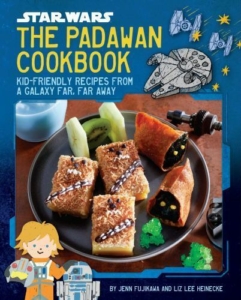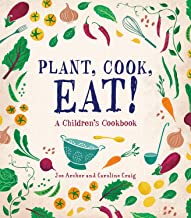Star Wars Fun




Titles Reviewed:
LEGO Star Wars in 100 Scenes by Daniel Lipkowitz
The Padawan Cookbook: Kid-Friendly Recipes From A Galaxy Far, Far Away by Jenn Fujikawa and Liz Lee Heinecke
Star Wars: The Complete Visual Dictionary–The Ultimate Guide to Characters and Creatures from the Entire Star Wars Saga by David West Reynolds and James Luceno
Star Wars Everyday: A Year of Activities, Recipes & Crafts From A Galaxy Far, Far Away by Ashley Eckstein
Officially, Star Wars Day is observed on May 4, as in “May the Fourth be with you.” In my family, however, it’s Star Wars Day everyday–mostly because my brother is a superfan who can tie just about any day and any thing back to the world of Star Wars. Why limit yourself to one day when there is an epic space saga to explore!
While searching for resources to celebrate the ongoing holiday, I ran across several titles that go beyond the usual fiction and graphic novel rehashing of the movies. Here is a quartet of nonfiction books tied to the Star Wars universe.
I’m a big fan of the heavily illustrated, informational books published by Dorling Kindersley (DK). Known for their clean layout with a focus on bright, engaging illustrations accompanied by easily digested, explanatory text, DK books offer an accessible entry to a multitude of topics. Star Wars: The Complete Visual Dictionary–The Ultimate Guide to Characters and Creatures from the Entire Star Wars Saga by David West Reynolds and James Luceno is a prime example. It offers the standard DK presentation of a 1-2 page spread on each entry consisting of full-color photos on white background, accompanied by informative summary paragraphs along with detailed captions and sidebars. The book provides comprehensive coverage of characters, creatures, and concepts from the films accompanied by a short glossary. What I like about the DK layout is that it accommodates whatever I have time or am in the mood for which can be anything from a targeted search to random browsing to a deep dive. I can treat it like a reference book or enjoy it as light reading. This title is great for both the casual and hard core Star Wars fan.
LEGO Star Wars in 100 Scenes by Daniel Lipkowitz, also a Dorling Kindersley publication, employs the same helpful visual focus. It is exactly what it claims–100 key scenes from Star Wars films (original and prequel trilogies) enacted in LEGOs. The book’s tagline is “six movies…a lot of LEGO bricks” for a reason. Full-color photos of LEGO sets and minifigures include speech bubbles of dialogue or self-referential text. Brick icons offer insight into LEGO sets related to the scene at hand. Sidebars offer commentary from C-3PO as an ongoing comedic bit. LEGO Star Wars in 100 Scenes is a fun title for elementary ages and up. There’s something here for everyone–LEGO builds, plenty of minifigs, and humorous, sarcastic asides (think family-friendly Mystery Science Theater 3000 commentary). Lots of fun for LEGO or Star Wars buffs!
Another entertaining title for elementary age and up is The Padawan Cookbook: Kid-Friendly Recipes From A Galaxy Far, Far Away by Jenn Fujikawa and Liz Lee Heinecke. It’s full of do-able recipes for a variety of ages with differing levels of kitchen experience and adult assistance. Both the content and presentation are enticing with colorful borders and line illustrations throughout along with jauntily displayed color photos for nearly every recipe. The book is divided into eight sections labeled to mimic Jedi Trials with a helpful glossary in the back. Each recipe lists prep time, cooking time, yield, and dietary consideration codes plus sidebars imparting a range of information about ingredients, techniques, culinary terms, food science, and tidbits from the Star Wars Universe. A handy measurement conversion chart and kitchen tools list round out the helps. The recipes themselves are colorful and entertaining whether it’s the frothy blue of the Bantha Milk Slushie (butterfly pea flower powder for the win) or the adorable Butter Chewies (butter mochi topped with toasted coconut and icing to resemble Chewbacca) or the bright Ahsoka’s Jelly Cubes (orange, blue, and white gelatin bound together and sliced) or the Sarlaac Shake (chocolate milkshake with a mouth and tentacles of pie dough rising from the top). The Padawan Cookbook has a positive, can-do vibe about it that encourages fun in the kitchen.
The Star Wars Universe has its share of hard core fans, and Ashley Eckstein, author of Star Wars Everyday: A Year of Activities, Recipes & Crafts From A Galaxy Far, Far Away, is no exception. A self-proclaimed superfan from childhood, Eckstein grew up to be the voice of Ahsoka Tano in the Star Wars: The Clone Wars animated series. When she says, “Star Wars is truly a lifestyle,” she means it. Arranged by month over the course of a year, the book offers crafts, recipes, party ideas, and mindfulness activities in each chapter. Each entry includes a brief description tying it to the Star Wars Universe. Many of the entries seem conventional approaches such as Hoth Chocolate Snowballs (white chocolate hot chocolate bombs), Bantha Suprise Burger Bites (tempura meatballs), Carbonite Clay Masks (home spa facial masks), Ewok House (decorated bird house), Cardboard Box Podracer (for kids to drive and adults to make), Planet Paper Lanterns, and a felt Boba Fett helmet stuffie. However, some activities appear to be a bit out of the ordinary including the Cloud City Dinner Party featuring the recipe Betrayal With A Side of Rice. (This is why I love nonfiction–some things you just can’t make up.) This, along with the incorporation of lifestyle activities, is certainly a new take on the Star Wars Universe for many fans although it is likely to attract the attention of a new audience. While some entries may seem a reach–budgetary or otherwise–there are also neat possibilities. Like the movies themselves, this title is interesting fun that can take itself a tad too seriously on occasion. Star Wars Everyday lends itself to an adult audience due to its approach, presentation appeal, and difficulty level of several activities.
Whether Star Wars is your jam or it’s another fandom, the Library has you covered! May the Force be with you!






